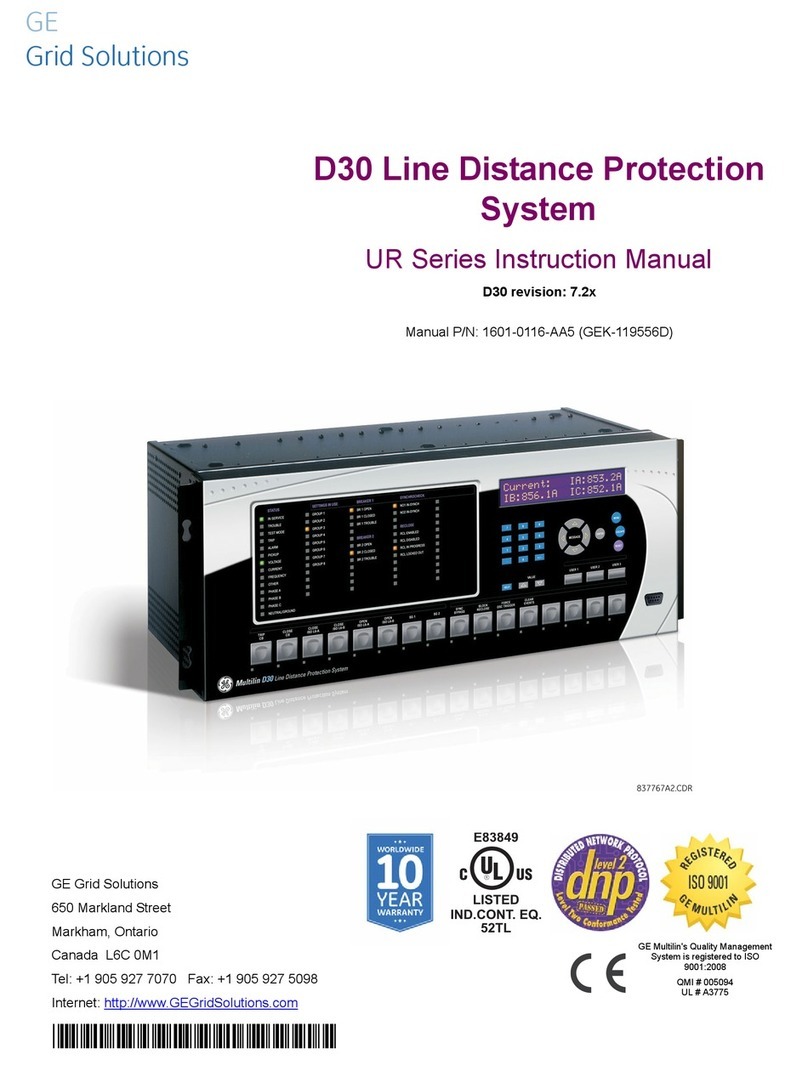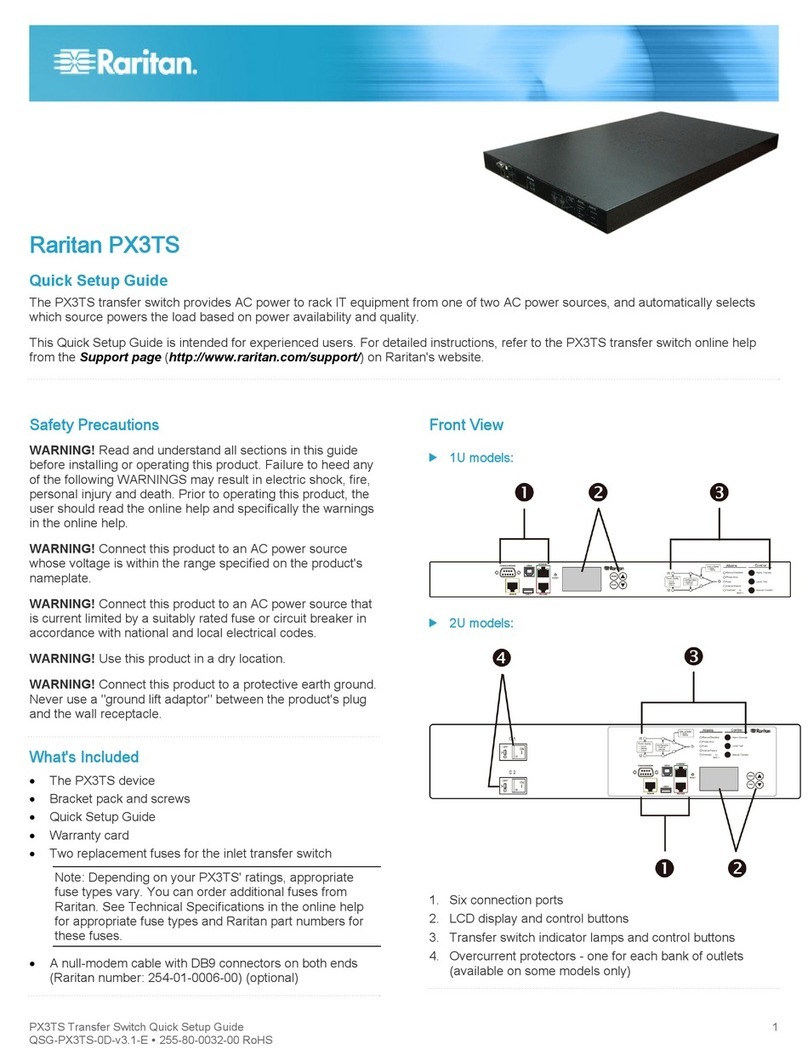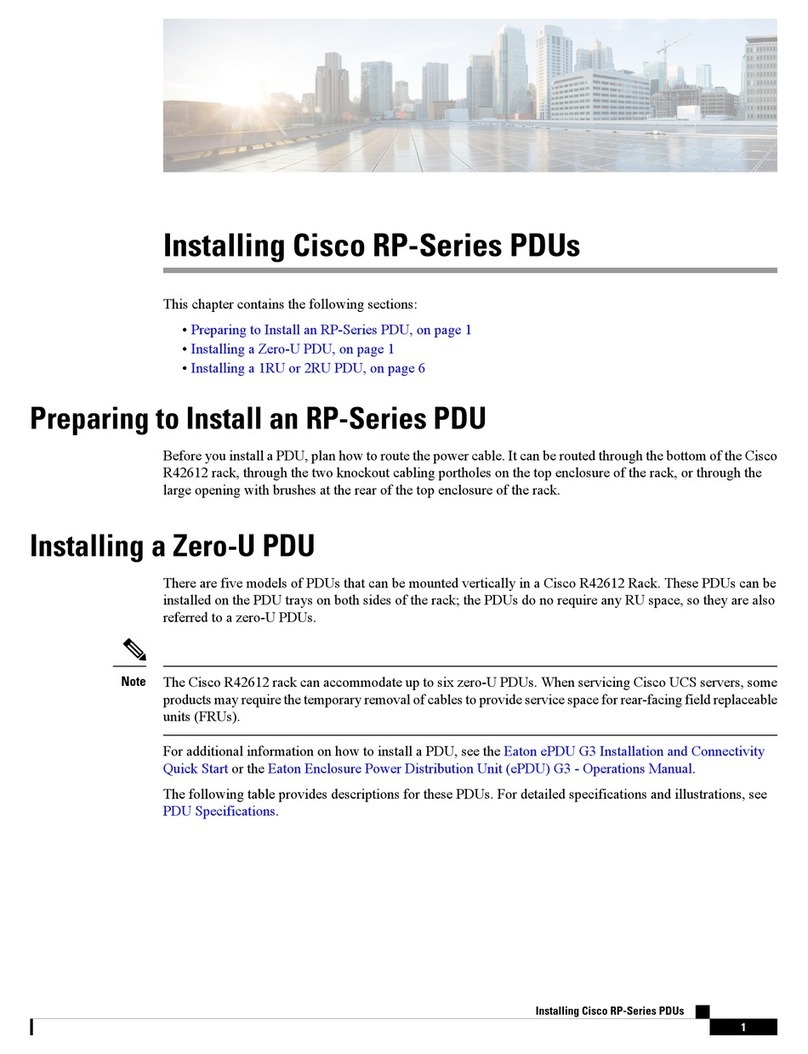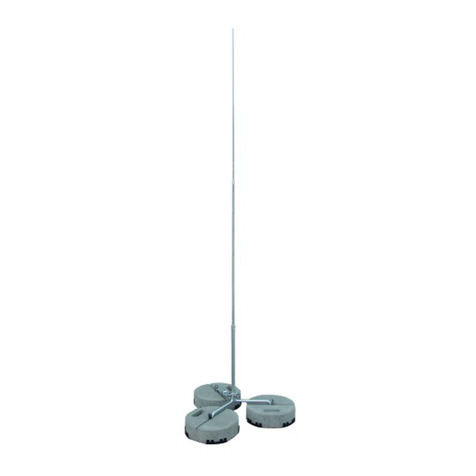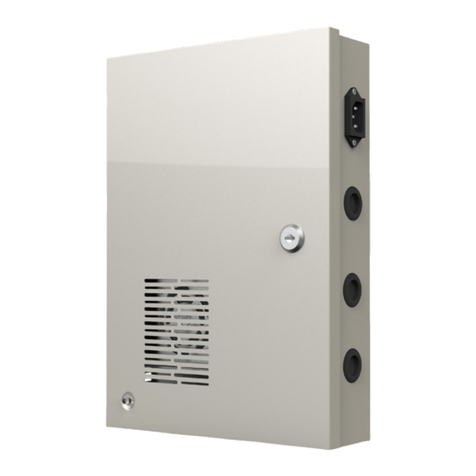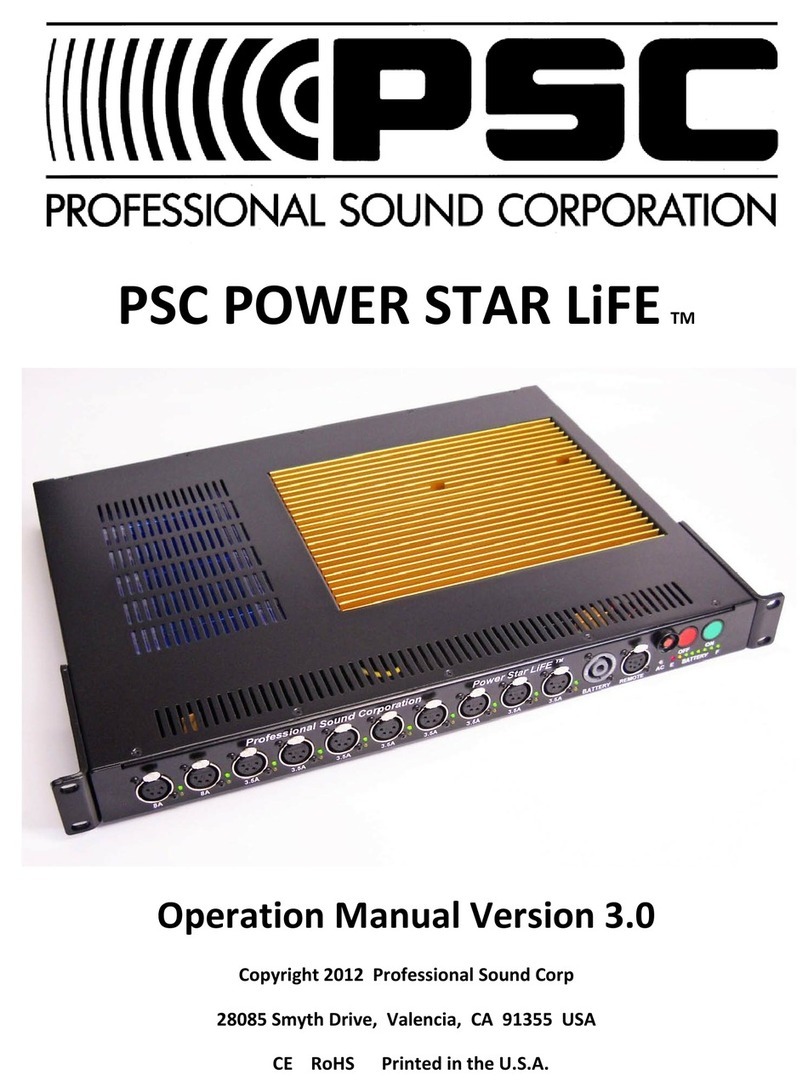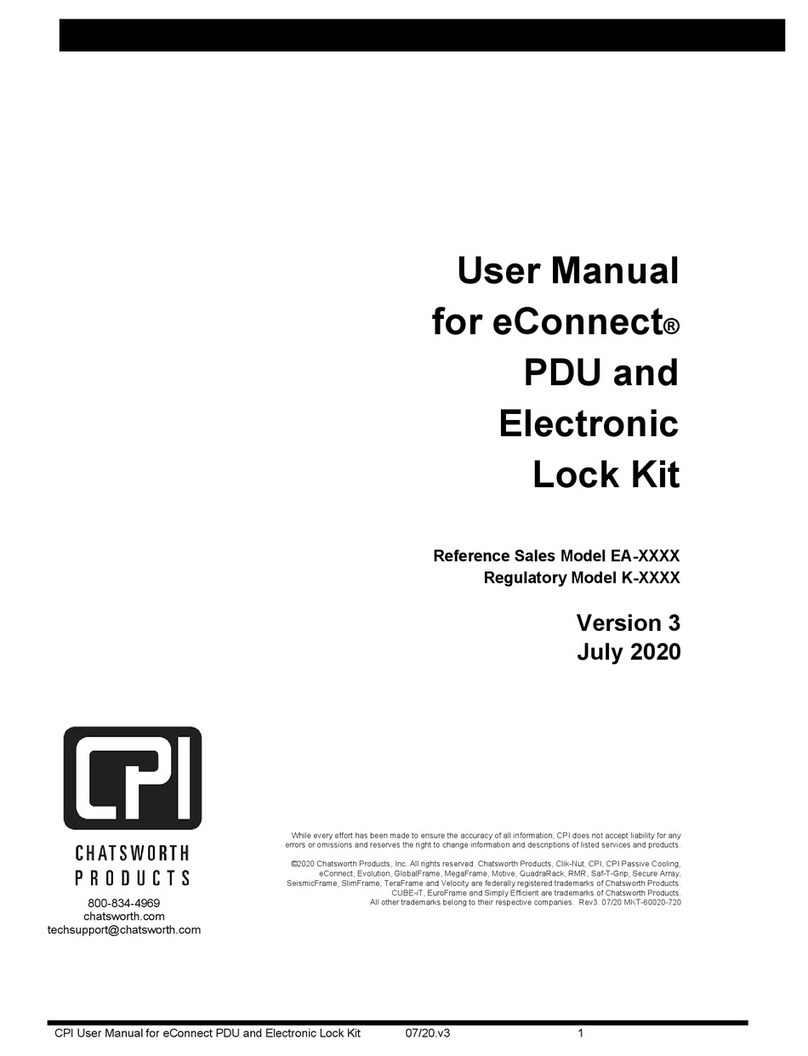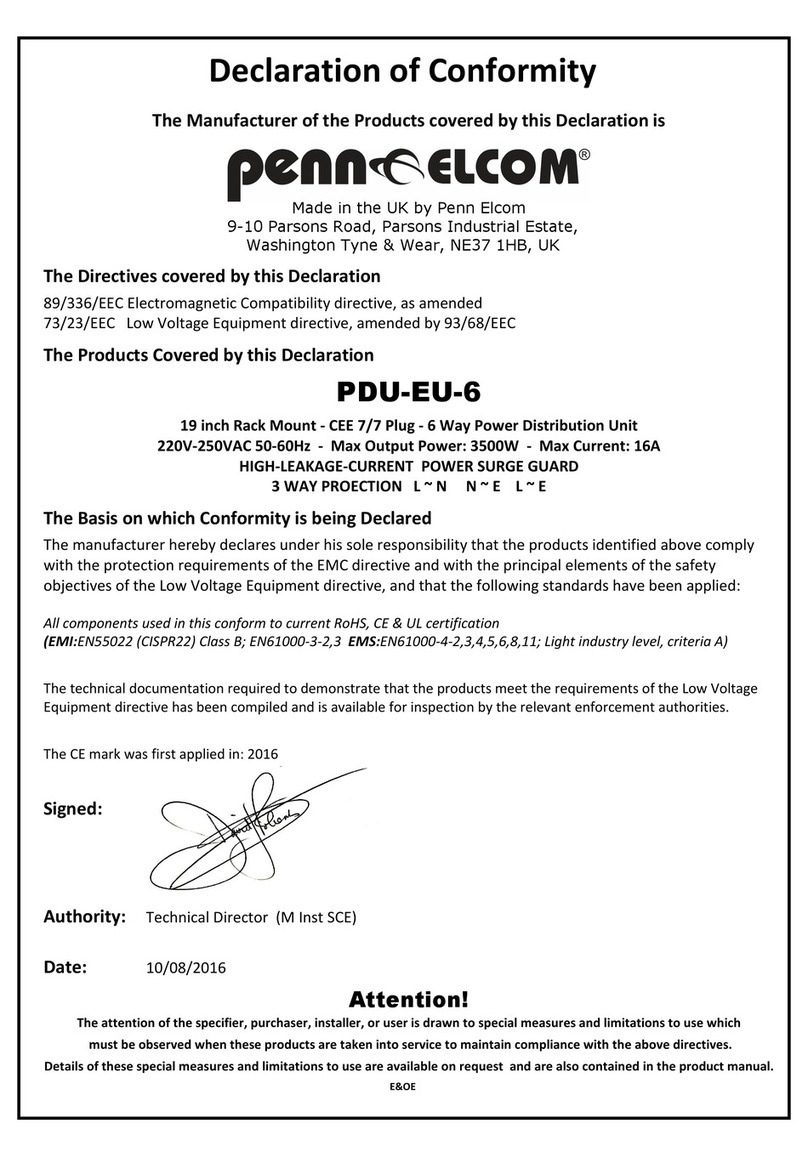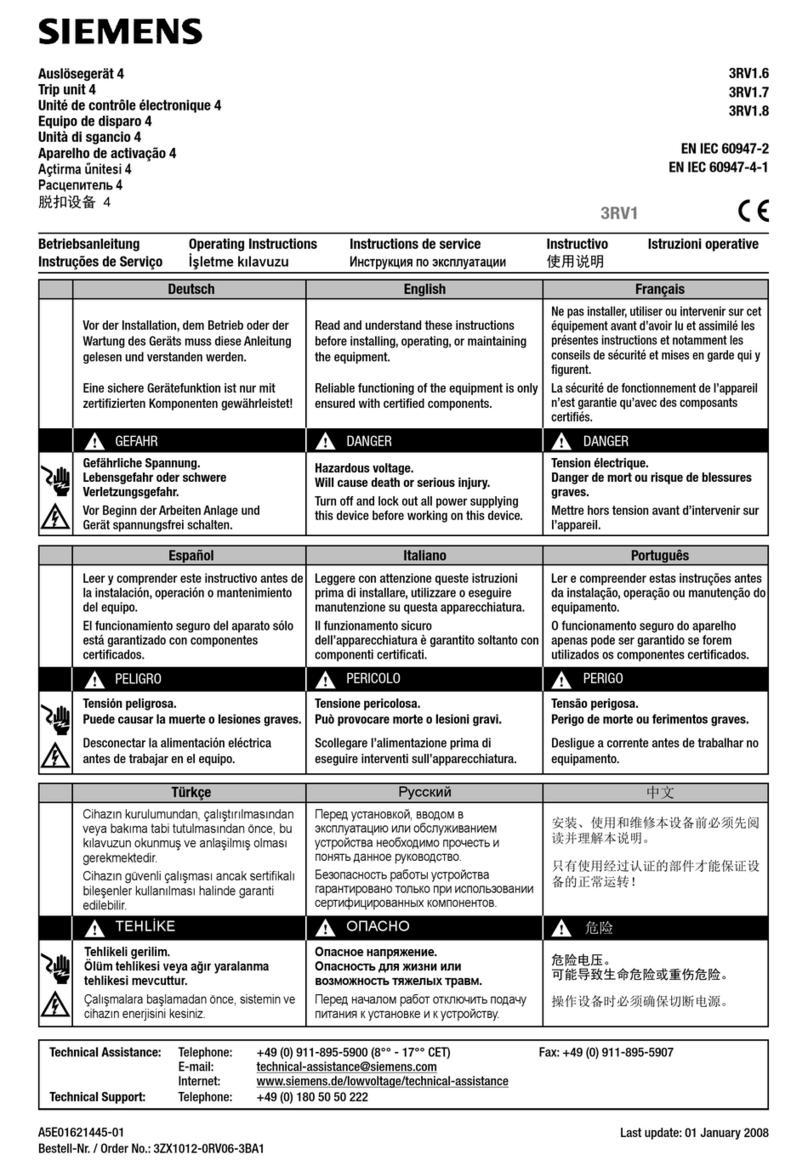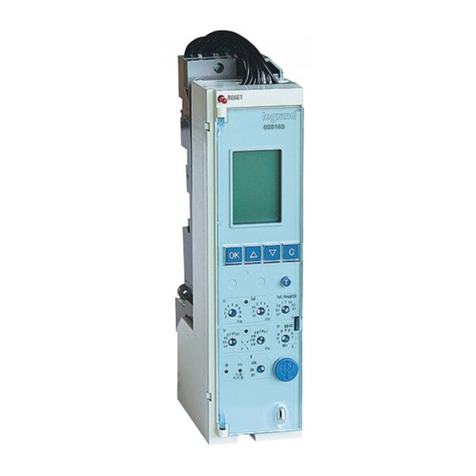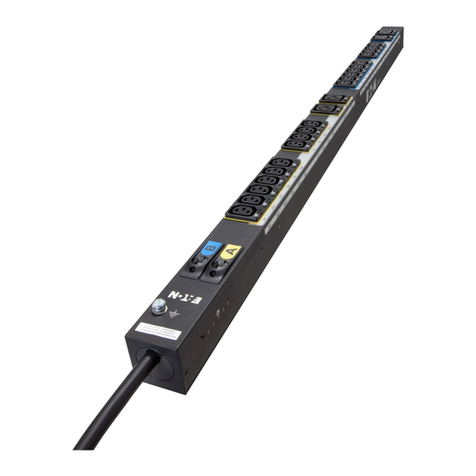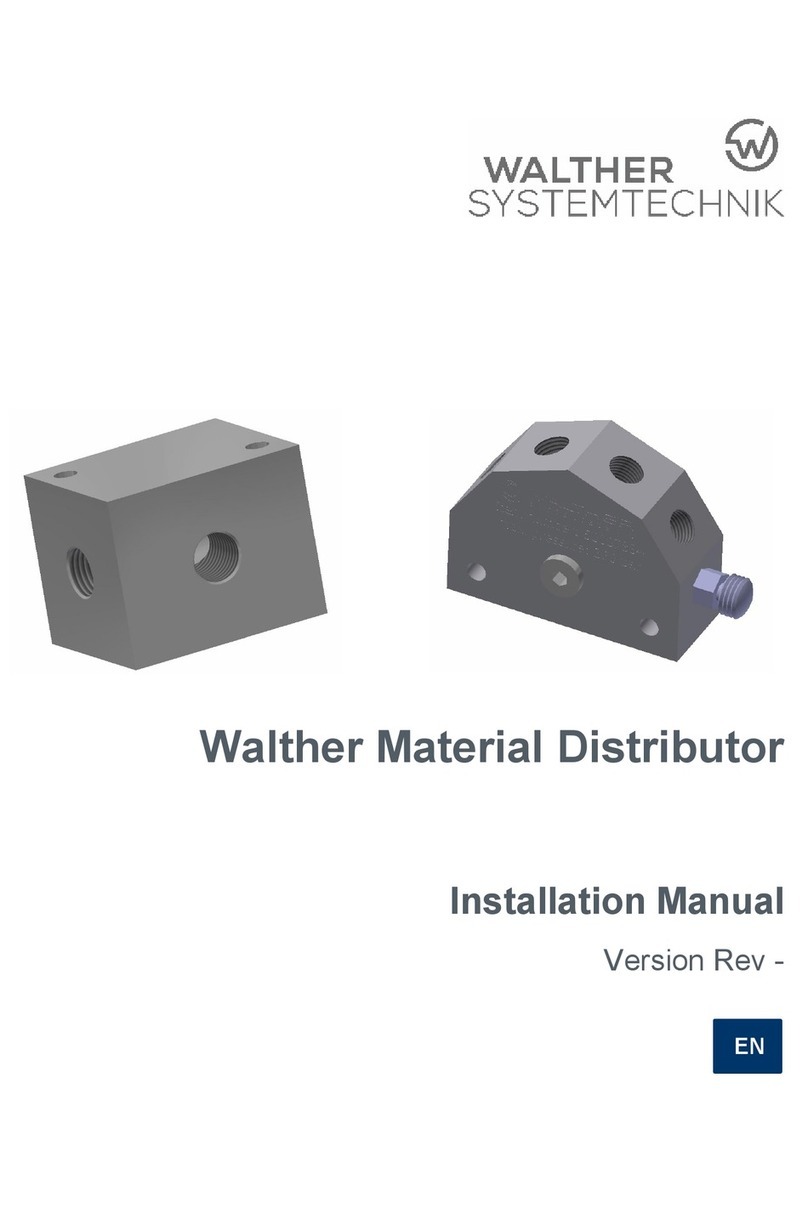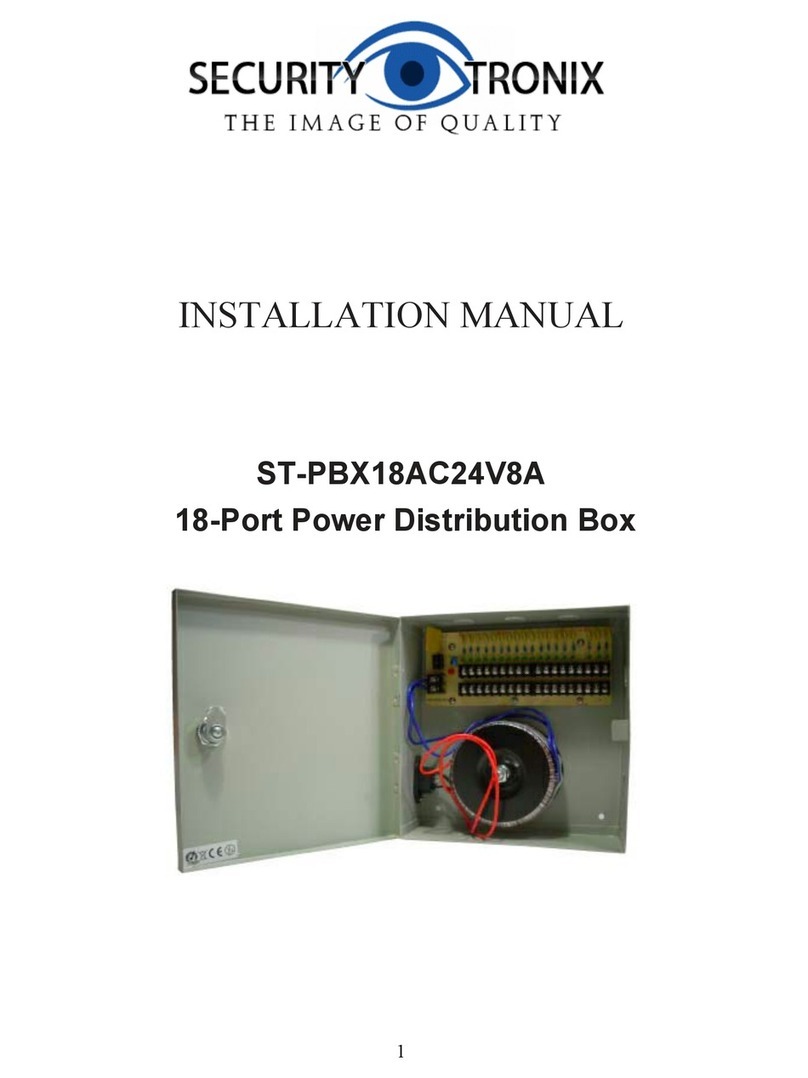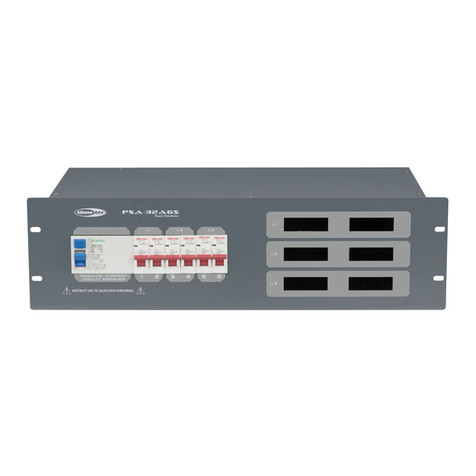DINA Elektronik DNDS Kompakt User guide

DNDS Kompakt
Original
Instruction manual
Only for replacement
requirements
Safety for men
and machines

Instruction manual DNDS Kompakt
Products: safety
technique
DNDS KOMPAKT Version 04 / 2011.03.16 page 2 from 20
Declaration of Conformity according to the machinery directive 2006/42/EC attachment II 1A
The protection target of the low voltage directive will be fulfilled according to attachment I. 1. 5. 1 of the machinery
directive.
Producer: DINA Elektronik GmbH
Address: Esslinger Str. 84, D-72649 Wolfschlugen
The producer declares, that the product DNDS Kompakt with the module types as follows
DNDS 1C
DNDS 1D
DNDS 2C
DNDS 2D
With optional external encoder adapter DNIA
DNDS 1FA
DNDS 1GA
DNDS 2FA
DNDS 2GA
With internal encoder adapter
is conform with the regulations of the directives stated above.
is conform with the regulations of the following directives:
•2004/108/EC: EMC-directive, EN55011 + A1, EN61000-6-2
•GS-ET-20: basic principles for testing and certification of safety switch devices"
•DIN EN 60947-5-1: Low-voltage switch gear and control gear; electromechanical control circuit devices
•DIN EN ISO 13849-1: Safety-related parts of control systems; Part 1: General principles for design
•DIN EN ISO 13849-2: Safety-related parts of control systems; Part 2: Validation
Remarks: The safety relevant functions according to the test report ll dated 28th Nov. 2007 will be with category 4
and Ple to perform.
Type test certificate (ET 08151 from 28.10.2008)
Additional notes:
Certificated by the „Fachausschuss für Elektrotechnik, Prüf- und Zertifizierungsstelle Köln“
European notified institution Id-number 0340
EMC-directive certificated by “ELMAC GmbH Bondorf”, Reg. No.: DAT-P-206/05-00
QM System certificated according to DIN EN ISO 9001:2008 by “DQS, Frankfurt”, Reg.-No.: 67542 QM 08
Wolfschlugen, 16.12.2009
General Manager
Signed of: Dirar Najib
Authorized person for the combination of the technical documents is Dirar Najib.
Address: Esslinger Street. 84, 72649 Wolfschlugen, Germany

Instruction manual DNDS Kompakt
Products: safety
technique
DNDS KOMPAKT Version 04 / 2011.03.16 page 3 from 20
DNDS Kompakt
Safety for men
and mashines
DNDS 1FA
DNDS 1GA
DNDS 2FA
DNDS 2GA
DNDS 1C
DNDS 1D
DNDS 2C
DNDS 2D
DNIA
DlNA Elektronik GmbH
Esslinger Straße 84
72649 Wolfschlugen
Tel. 07022/9517-0
Fax 07022/95 17-51
www.dinaelektronik.de
Quality management
system
DQS Certificate
DIN EN ISO 9001: 2008
Reg.-Nr.67542 QM 08
BG Verification
certificate ET 08152
MTTF
d
= 123 years
DC
avg
: ≥
≥≥
≥99%
CCF: 95 points
PFH
d
: 2.47x10
-8
PI = e
T
M
= 20 years
The total concept of the specified category must be validated involving the whole control unit.

Instruction manual DNDS Kompakt
Products: safety
technique
DNDS KOMPAKT Version 04 / 2011.03.16 page 4 from 20
Contents Page
Safety regulations ......................................................................................................................................................5
Intended usage .............................................................................................................................................................5
Addition’s according 13849-1 .......................................................................................................................................5
Product variants of motion and standstill monitoring system .......................................................................................6
Description of DNDS 1C, 1D, 1FA, 1GA, 2C, 2D and 2GA..........................................................................................6
Requirements of the encoder .......................................................................................................................................6
Reaction times ..............................................................................................................................................................6
Circuit diagram..............................................................................................................................................................7
DNDS 1C, 1FA, 2C, 2FA: Applications of the outputs..................................................................................................7
SPEED contacts: Motion monitoring ............................................................................................................................7
DNDS 1D, 1GA, DNDS 2D, 2GA: Applications of the outputs .....................................................................................8
STOP contacts: Standstill monitoring ...........................................................................................................................8
SPEED contacts: Motion monitoring ............................................................................................................................8
Function description: DNDS 1C, 1D, 1FA & 1GA.........................................................................................................9
Function of the inputs of DNDS 1C, 1D, 1FA & 1GA....................................................................................................9
Machine speed setting with DNDS 1C, 1D.................................................................................................................10
Machine speed setting with DNDS 1FA, 1GA ............................................................................................................10
Function modes ..........................................................................................................................................................10
Reaction times ............................................................................................................................................................11
Installation of DNDS 1C, 1D, 1EA, 1GA .....................................................................................................................11
Faults - Errors of DNDS 1C, 1D, 1FA, 1GA................................................................................................................11
Function of DNDS 2C, 2D and 2GA ...........................................................................................................................12
Function of the inputs of DNDS2 C, 2D......................................................................................................................12
Machine speed setting with DNDS 2C, 2D.................................................................................................................12
Machine speed setting with DNDS 2GA.....................................................................................................................12
Reaction times ............................................................................................................................................................13
Installation of DNDS 2C, 2D, 2GA..............................................................................................................................13
Faults - Errors of DNDS 2C, 2D and 2GA ..................................................................................................................13
Dimensions .................................................................................................................................................................14
Technical data.............................................................................................................................................................14
DNIA adaptor to the encoder: product description .....................................................................................................15
DNIA: function description ..........................................................................................................................................15
Requirements of the encoder .....................................................................................................................................15
DNIA: Installation and operation .................................................................................................................................15
Adjustment of the NC type..........................................................................................................................................15
Certificate....................................................................................................................................................................17

Instruction manual DNDS Kompakt
Products: safety
technique
DNDS KOMPAKT Version 04 / 2011.03.16 page 5 from 20
Safety regulations
•The unit may only be installed and operated by those who are qualified electrical engineers or have received sufficient train-
ing and are familiar with both these instructions and the current regulations for safety at work and accident prevention.
Follow VDE, EN as well as local regulations especially as regards preventative measures!
•Ignoring the safety regulations can lead to death, serious injury or cause considerable damage!
•In emergency stop applications use the internal function “Speed output restart disable” or a higher level control unit must
ensure that the machine cannot start up again automatically!
•Transport, storage and operating conditions should all conform to EN 60068-2-1, 2-2. See technical details
•Any guarantee is void following unauthorised modifications. This can lead to death, serious injury or cause considerable
damage!
•The unit should be cabinet mounted, otherwise dampness or dust could lead to functional impairment.
•Adequate fuse protection must be provided on all output contacts especially with capacitive and
inductive loads.
•The unit must be installed following the specification of DIN EN 50274, VDE 0660-514 regarding the required distances.
•During operation, parts of the electronic switchgear carry high voltage.
•DANGER! During operation the protective covers must not be removed from the electronic switchgear!
•The device must always be replaced after the first malfunction!
•The unit must be disposed of properly when it reaches the end of it service life.
•Keep the operating instructions!
Intended usage
The intended usage of the motion and stand-still monitor DNDS is:
•Safe motion monitoring according to EN 60 204-1; VDE 0113-1 and DIN EN ISO 13849-1 Category 4 PLe
•Safe stand-still monitor according to EN 60204-1; VDE 0113-1 and DIN EN ISO 13849-1 Category 4 PLe
(Type test certificate No. ET 08151, BG Test certificate No. ET 08152)
Certification base:
•2004/108/EC: EMC-directive, EN55011 + A1, EN61000-6-2
•GS-ET-20: basic principles for testing and certification of safety switch devices"
•DIN EN 60947-5-1: Low-voltage switch gear and control gear; electromechanical control circuit devices
•DIN EN ISO 13849-1: Safety-related parts of control systems; Part 1: General principles for design
•DIN EN ISO 13849-2: Safety-related parts of control systems; Part 2: Validation
Addition’s according 13849-1
•The boundaries of the SRP/CS start at the clamps of the input signals and will end at the clamps of the contact
driven enable path
•Changing, Repair and maintenance by the user is not intended. Exclusions of errors made, will stay valid un-
changed.
The requirements below are described in this product information:
•Description of the interfaces to SRP/ CS and safety equipment (described module dependent)
•Reaction time (page 6, 11, 13 and 14)
•Limits of operation (page 14, 16)
•Indicators and alarms (page 11 and 13)
•Muting and temporary disabling of the safety functions (not valid here)
•Operation mode’s general description (page 10 and 12)
•Maintenance, Checklists and internal spare parts (not valid here)
•Tools for easy and safe troubleshooting (page 11 and 13))
•Test intervals (not valid here)
Risk diagram to determine the PL
r
for every safety fun
c
tion
Legend
Llow impact on risk reduction
Hhigh impact on risk reduction
PL
r
necessary performance Level
Risk parameters
Ssevere of injury
S1 light (normally reversible injury)
H
L
P1
P2
P1
P1
P1
P2
P2
P2
Start
a
b
c
d
e
F1
F2
F2
F1
S1
S2
PLr
S2 severe (normally irreversible injury including dead)
Ffrequency and/or duration of the danger situation
F1 seldom to infrequent and/or short exposition to danger situation
F2 frequent or constant and/or long exposition to danger situation
Ppossibilities to circumvent the danger or limitation of damage
P1 possible under certain conditions
P2 nearly impossible
The requirements of the standards can be fulfilled, if after the operating time the protection device will be activated or
the safety functions will be tested.

Instruction manual DNDS Kompakt
Products: safety
technique
DNDS KOMPAKT Version 04 / 2011.03.16 page 6 from 20
Product variants of motion and standstill monitoring system
Ou
t
puts
Equi
p
ment
Monitoring actuations STOP SPEED
DNDS 1C
1
DNDS 1D
1
13 2314 24
33 43 4434
DNDS 1FA
1
DNDS 1GA
1
13 2314 24
33 43 4434
DNDS 2C
2
DNDS 2D
2
13 2314 24
33 43 4434
DNDS 2GA
2
13 2314 24
33 43 4434
to use only as reporting co
n
tact
Accessories
Equi
p
ment
Equi
p
ment function
DNIA
Adapter to the encoder
DNDA
Cable adapter for the encoder
Description of DNDS 1C, 1D, 1FA, 1GA, 2C, 2D and 2GA
The DNDS is enclosed in a 100mm housing and requires a supply voltage of 24 VDC.
Features:
DNDS 1C, 2C & DNDS 1FA:
for standstill monitoring one safety contacts (13 14) and one NC contact (11 12)
for motion monitoring one safety contacts (23 24) and one NC contact (21 22), positive guided.
DNDS 1D, 2D, DNDS 1GA & 2GA:
for standstill monitoring two safety contacts (13 14 23 24)
for motion monitoring two safety contacts (33 34 43 44), positive guided.
DNDS 1C, 1D, DNDS 2C & 2D:
Connections for PNP-proximity sensors or an encoder via a DNIA adaptor.
DNDS 1FA,DNDS 1GA & 2GA:
The encoder is connected via a DNDA Cable adaptor type DNDA.
Status indicators.
Programmable machine rpm setting.
The DNDS complies with the following safety requirements:
•
The circuit is redundant with built-in self-monitoring.
•
The safety function remains effective in the case of a component failure.
•
With every on-off cycle of the machine the relays are automatically tested to make sure they open and close
correctly.
Signals of encoder
Requirem
ents of the encoder
•
Encoder signal: Rectangular with amplitude of 0.5-5 V or si-
ne/cosine signal with 0.5-5 VSS.
•
Encoder frequenzy ≤
≤≤
≤300KHz TTL, 200KHz Sin/Cos.
•
Encoder with high resistance outputs during malfunction.
•
2 tracks 90°out of phase, 2 signals per track that are 180°out
of phase
•
The signals of encoder are not allowed to be generate syntheti-
cally
A
A*
B
B*
Sin
Sin*
Cos
1Vss
Cos*
1V-5V TTL
Reaction times
The total reaction time is the sum of:
•
Reaction time of the motion monitor
•
De-energisation time of the output relay (<20ms).
•
Delay of de-energisation on any external switching devices.
The reaction time of the motion monitor decreases as the speed to be monitored increases (linear).
It measures at 5 Hz about 200 ms and at 800 Hz about 1 ms

Instruction manual DNDS Kompakt
Products: safety
technique
DNDS KOMPAKT Version 04 / 2011.03.16 page 7 from 20
Circuit diagram
DNDS1C
Motion detection:
proximity se
n
sors
DNDS 1D
Motion detection:
e
n
coder
24VDC
Überwachung
Monitoring
Surveillance
A1 A2 F2 F3 F4 11 12 13 14
D2 D3 D4 21 22 23 24
IN1
IN2
F1
D1
24VDC
Surveillance
A1 A2 F1 13 14 23 24
33 34 43 44
IN1
Überwachung
Monitoring
1.
2.
F2 F3 F4
D1IN2 D2 D3 D4
A1
A1 IA1
IA1
IA2
IA2
DNDA --/15
DNIA
DNDS 1FA
Motion detection:
e
n
coder
DNDS 1GA
Motion detection:
enc
o
der
24VDC
Surveillance
A1 A2 F1 F2 F3 F4 11R
Überwachung
Monitoring
D1 D2 D3 D4SH
12 13 14
21 22 23 24
Encoder
Meßsystem
24VDC
Surveillance
A1 A2 F1 F2 F3 F4 13R
Überwachung
Monitoring
D1 D2 D3 D4SH
14 23 24
33 34 43 44
Encoder
Meßsystem
DNDS 2C
Motion detection:
proximity se
n
sors
DNDS 2D
Motion detection:
e
n
coder
24VDC
Überwachung
Monitoring
Surveillance
A1 A2
IN1
D1 D2 D3 11 12 13 14
D4 D5 D6 21 22 23 24
IN2
IN3
IN4
1.
2.
DNIA
DNDA --/15
IA1
IA1
A1
A1 IA2
IA2
24VDC
Surveillance
A1 A2 IN2 13 14 23 24
33 34 43 44
IN1
Überwachung
Monitoring
1.
2.
D1 D2 D3
IN4IN3 D4 D5 D6
A1
A1 IA1
IA1
IA2
IA2
DNDA --/15
DNIA
DNDS 2GA
Bewegungserfassung:
Encoder
Motion detection: encoder
24VDC
Surveillance
A1 A2 D11 D12 D13 D14 13SH11
Überwachung
Monitoring
1.
2.
D21 D22 D23 D24SH21
14 23 24
33 34 43 44
Encoder
Meßsystem
Encoder
Meßsystem
DNDS 1C, 1FA, 2C, 2FA:
Applications of the outputs
STOP contacts: Standstill monitoring
If the protection cover is closed and one or more drives are in movement, the NO-contacts 13-14 open immediate-
ly. The NC-contacts 11-12 close. The LED STOP is not illuminated. The protection cover cannot be opened.
If all drives are stopped the contacts 13-14 close and 11-12 close. The protection cover can be opened. The LED
STOP is illuminated.
SPEED contacts: Motion monitoring
If the protection cover is closed, the F-inputs and
respectively the D-inputs of DNDS will be connected
to 24V DC via the switch of the protection cover. The
automatic mode will be monitored.
In case of the protection cover is open DNDS moni-
tors the standstill of all drives, if there is no function
mode selected.
If there is some function mode selected, as example
tool setting via SH-, R-input of DNDS, this function
mode will be monitored.
If one or more drives break the standstill as well as
the adjusted speed of the function mode, the NO
contacts 23-24 open and 21-22 close immediately.
The LED SPEED does not illuminated.
The drives will be stopped by emergency stop circuit
(STOP category 0). See principal schematic.
The contacts 23-24 close and 21-22 open again, if
the actual speed is 10% lower than the adjusted
speed. The LED SPEED illuminates.
Emergency stop
circuit
24
23
22
21
11
12
13
14
STOP
SPEED
L1
L2
to unlock
cover
Magnets
for bolt
DNDS
DNDS F- or D-inputs
Quit
Protection cover
switch
11 13
12 14
21 23
22 24
24V DC
CNC
Information contacts

Instruction manual DNDS Kompakt
Products: safety
technique
DNDS KOMPAKT Version 04 / 2011.03.16 page 8 from 20
DNDS 1D, 1GA, DNDS 2D, 2GA: Applications of the outputs
STOP contacts: Standstill monitoring
If the protection cover is closed and one or more drives are in movement, the NO-contacts 13-14 and 23-24 open
immediately. The LED STOP is not illuminated. The protection cover cannot be opened.
If all drives are stopped the contacts 13-14 and 23-24 close. The protection cover can be opened. The LED STOP
is illuminated.
SPEED contacts: Motion monitoring
If the protection cover is closed, the F-inputs and respectively the D-inputs of DNDS will be connected to 24V DC
via the switch of the protection cover. The automatic mode will be monitored.
In case of the protection cover is open DNDS monitors the standstill of all drives, if there is no function mode se-
lected.
If there is some function mode selected, as example tool setting via SH-input or R-input of DNDS, this function
mode will be monitored.
If one or more drives break the standstill as well as the adjusted speed of the function mode, the NO contacts
23-34 and 43-44 open immediately. The LED SPEED does not illuminated.
The drives will be stopped by emergency stop circuit (STOP category 0). See principal schematic below.
The contacts close again, if the actual speed is 10% lower than the adjusted speed. The LED SPEED illuminates.
Parallel connection of the outputs
Serial connection of the outputs
Emergency stop
circuit
44
43
34
33
13
14
23
24
STOP
SPEED1
L1
L2
to unlock
cover
Magnets
for bolt
DNDS
DNDS-monitoring modules
Quit
Protection cover
switch
11 13
12 14
21 23
22 24
24V DC
Machine
control
Emergency stop
circuit
44
43
34
33
13
14
23
24
STOP
SPEED1
L1
L2
to unlock
cover
Magnet
for bolt
DNDS
DNDS-Monitoring modules
Quit
Protection cover
switch
11 13
12 14
21 23
22 24
24V DC
Machine
control
If it necessary the stop contacts can be serial, the speed contact can be parallel and contrary.
Function diagram
DNDS 1C, 1FA & 2C
DNDS 1D, 1GA, 2D & 2GA
21 22
Drehzahl
t
23 24
Speed
Vitesse
t
Vitesse
13 14
11 12
UB =
24 V DC
Stillstand
Arrêt
Standstill
Speed
Drehzahl
n2
n1
t
t
t
UB =
24 V DC
Vitesse
Drehzahl
Speed
33
43
Standstill
Arrêt
Stillstand 13
23
34
44
14
24
Drehzahl
Speed
Vitesse
n1
n2
t
t
t
t
t
t

Instruction manual DNDS Kompakt
Products: safety
technique
DNDS KOMPAKT Version 04 / 2011.03.16 page 9 from 20
Function description: DNDS 1C, 1D, 1FA & 1GA
DNDS 1C, 1D, 1FA & 1GA:
The DNDS acts as a failsafe monitor of a rotary respectively linear motion and standstill. The speed monitor shut-
down trigger point can be programmed via 4 inputs (D1–D4). This shutdown trigger point can be further modified
from 100% down to 5 % via the 4inputs (F1–F4)
DNDS 1C, 1D has an internal (R) input to switch between constant and variable creep velocity (see table 1 and 2).
The motion detection can be monitored via 2 PNP-proximity sensors or a rotary encoder.
If PNP-proximity sensors are used, attention must be paid to mount them in a way, so always one of the two sen-
sors is activated.
Rotary encoders can only be connected using a DNIA adaptor (for the rotary encoder specifications, see the DNIA
operating instructions).
DNDS 1FA, 1GA has an external (R) input to switch between constant and variable creep velocity. A further exter-
nal (SH) input is used for switching over between creep velocity and standstill (see table 1 and 2).
For motion monitoring a rotary encoder is required. The Rotary encoder is connected via a DNDA 15/8 or DNDA
25/8 adaptor to the DNDS 1FA, 1GA
Function of the inputs of DNDS 1C, 1D, 1FA & 1GA
D-inputs:
-
Setting the automatic operation mode speed in 16 steps (00-15 = 100 – 800 Hz, table 1)
-
D-inputs are only of importance if at least one F-input is connected to 24V
-
If the F-inputs are not active (open) and the R-input is active, the active D-inputs determine the value of the tool
setting speed.
F-inputs:
-
F-inputs reduce the stting value via the D-inputs in 15 steps, 01-15 = 25-100%.
-
The F-inputs are also a switch over between tool setting (all F= open) and automatic operation mode (any F con-
nected with 24V). The tool setting speed is variable between 1-20 Hz or constant 5 Hz.
-
The F-inputs setting is store internally to determine the tool setting speed, if all F inputs are switched off. The
stored F setting is valid until the equipment is powered off.
-
The value of the tool setting speed is determined by the stored F-inputs, if the D-inputs are open and the R-input
is active.
R-input:
-
R-input works only if the F-inputs are switched off (open).
-
If the R- and D-inputs are active the creep rate is determined by the active D-inputs. (see Table 1)
-
If the D-inputs are open the tool setting speed is determined by the stored F setting .
-
If the R-input and the Finputs are not active, the standstill is monitored.
-
R- and SH inputs must not be connected to 24V at the same time.
SH-input: DNDS 1FA, 1GA only
-
The SH input is used to switch between tool setting speed and standstill (50Hz and 5Hz)
-
The SH-input works only if the R-input and all F-inputs are switched off (open).
-
If the SH-input and the F-inputs are open the standstill will be monitored.
-
If the SH-input is active (SH connected to 24V) and the F-inputs are open the tool setting speed will be moni-
tored.

Instruction manual DNDS Kompakt
Products: safety
technique
DNDS KOMPAKT Version 04 / 2011.03.16 page 10 from 20
Machine speed setting with DNDS 1C, 1D
connected to24 VDC
NC = open
T1
speed setting
T2
Reduction in % for each position of D in
T1
Automatic mode
F1
-
F4 = NC
Automatic mode D D + F = NC
Programmable
F=
Mode 2 internal
Programmable = Mode 2 internal
inputs
100%
R
R
inputs 0-15
R
R
T1
D1
D2
D3
D4
HZ
Hz
Hz
T2
F1
F2
F3
F4
%
Hz
Hz
00
100
2,5
00
5
The 01
112
2,8
Reduction 01 25
1,0
frequencies 02
140
3,5
in % 02 30
1,1
are the 03
180
4,5
This is valid 03 35
1,2
input 04
200
5,0
for each 04 40
1,3
frequencies 05
224
5,6
position 05 45
1,4
at the 06
275
7,0
in
T1
06 50
1,5
IN1, IN2 07
315
8,0
5
07 55
1,6
Inputs of 08
355
9,0
08 60
1,7
the 09
400
10,0
09 65
1,8
DNDS 1C, 10
450
11,0
10 70
1,9
DNDS 1D. 11
500
12,5
11 75
2,0
12
550
14,0
12 80
2,1
13
630
16,0
13 85
2,2
14
700
17,5
14 90
2,3
15
800
20,0
15 100
2,5
Mode 2 internel: internal ajusment only by DINA Elektronik. Mode 2 ist only active if F = NC
Machine speed setting with DNDS 1FA, 1GA
connected to24 VDC
NC =
open
T1
Automatic mode speed setting (mode 1)
T2
Reduction in % for each position of D in
T1 (mode 1)
Programmable
F =
F = NC
Programmable D =
D + F = NC
inputs
100%
R
SH
R&SH
inputs 0-15
R
SH
R&SH
T1
D1
D2
D3
D4
HZ
Hz
Hz
Hz
T2
F1
F2
F3
F4
%
Hz
Hz
Hz
00
100
2,5
00
The 01
112
2,8
Reduction 01
25
1,0
frequencies 02
140
3,5
in % 02
30
1,1
are the 03
180
4,5
This is valid 03
35
1,2
frequencies 04
200
5,0
for each 04
40
1,3
at the output 05
224
5,6
position in
T1
05
45
1,4
of the 06
275
7,0
06
50
1,5
intermediate 07
315
8,0
50
5
07
55
1,6
50
5
adaptor 08
355
9,0
08
60
1,7
09
400
10,0
09
65
1,8
10
450
11,0
10
70
1,9
11
500
12,5
11
75
2,0
12
550
14,0
12
80
2,1
13
630
16,0
13
85
2,2
14
700
17,5
14
90
2,3
15
800
20,0
15
100
2,5
R: Selection of tool setting function mode for spindle operation, F = NC
SH: Selection of tool setting function mode for linear movement, F = NC
F & SH = NC: Standstill monitoring
Function modes
SH-input R-input F-inputs D-input Monitored modes
Dx at 24V or open Standstill
24V
Dx at 24V or open Tool setting
24V
Dx at 24V or open Tool setting
Fx=24V Dx at 24V or open Automatic
Priority of the inputs: F > R > standstill, F > SH > standstill

Instruction manual DNDS Kompakt
Products: safety
technique
DNDS KOMPAKT Version 04 / 2011.03.16 page 11 from 20
Reaction times
The total reaction time is the sum of:
•
Reaction time of the motion monitor
•
De-energisation time of the output relay (<20ms).
•
Delay of de-energisation on any external switching devices.
The reaction time of the motion monitor decreases as the speed to be monitored increases (linear).
It measures at 5 Hz about 200 ms and at 800 Hz about 1 ms
Installation of DNDS 1C, 1D, 1EA, 1GA
•
The equipment must be cabinet mounted min. IP 54). The Equipment is equipped with a latch for DIN-rail at-
tachment.
•
Supply operating voltage of 24V to terminals A1 (+) and A2 (-). Connect button (reset fault memory) to terminal
A2.
•
Input circuit: DNDS 1C, 1D
- Proximity sensor (PNP):
Connect output of the first proximity sensor to IN1 and the 2nd to IN2. Both proximity sensors should be con-
nected to supply voltage A1 and A2.
- Encoder with DNIA adaptor:
Connect output IA1 of the DNIA to terminal IN1; connect output IA2 of the DNIA to terminal IN2; A1 of both
units should be connected together.
•
Programming
- rpm setting: Connect 24 VDC to the terminals D1-D4 according to desired rpm (see table 1).
- Reduction in %: Connect 24 VDC to the terminals F1-F4 according to table 2.
•
Input circuit: DNDS 1FA, 1GA
-
Connect the Equipment by using a DNDA 15/8 or DNDA 25/8 adapter cable to the encoder.
Please note for operation
•
To prevent a welding together of the contacts, a fuse (6 A slow acting) must be connected before the output
contacts.
•
The total of the reaction times must not lead to a dangerous status.
•
Use copper wiring that will withstand 60/75°C.
•
Tighten screws to terminals with 0.8 Nm max.
•
Important details in the section “Technical Data” should be noted and adhered to.
Faults - Errors of DNDS 1C, 1D, 1FA, 1GA
•
Welding of one contact makes it impossible for the other contact to be switched on.
•
LED “SPEED” and “STOP” do not light:
A PNP proximity sensor failure.
PNP proximity sensor not connected.
PNP proximity sensor is not installed on the tooth wheel.
There is a line break to the DNIA.
The encoder is not connected.
•
LED “SPEED” flashes with 1 Hz interval:
The peripheral equipment belonging to input IN2 is defective or there is a line break at that input, or Track A of
the encoder is missing.
•
LED “STOP” flashes with 1 Hz interval:
The peripheral equipment belonging to input IN1 is defective or there is a line break at that input or Track B of
the encoder is missing.
To reset the error disconnect the operating voltage for at least 2s (disconnect A1)
•
LED “STOP” and LED “SPEED” flashes in 2 Hz intervals:
R and SH connected to 24V simultaneously.
DNDS 1C disturbance.
Error by improperly installed external signal lines.
The fault can possibly be eliminated by interruption of the operating voltage for at least 2s (disconnect A1).

Instruction manual DNDS Kompakt
Products: safety
technique
DNDS KOMPAKT Version 04 / 2011.03.16 page 12 from 20
Function of DNDS 2C, 2D and 2GA
The DNDS 2C, 2D, 2GA includes 2 independent monitoring systems for failsafe monitoring of a rotary respectively
linear motion and standstill .
DNDS2 C, 2D:
The machine rpm setting is done by 3 programmable inputs for each system.
The motion detection can be monitored by 2 PNP proximity sensors or one encoder per monitoring system. If PNP-
proximity sensors are used, attention must be paid to mount them in a way, so always one of the two sensors is
activated.
Rotary encoders can only be connected using a DNIA adaptor (for the rotary encoder specifications, see the DNIA
operating instructions).
DNDS 2GA:
The machine rpm setting is done by 4 programmable inputs for each systems.
Each system uses its own encoder to monitor the motion. The encoder can only be connected using a DNDA 15/8
or 25/8 adaptor (for specifications of the rotary encoder, see the impulse diagram)
Function of the inputs of DNDS2 C, 2D
D-inputs:
-
Position 0-7 (T1), DNDS 2C, 2D
-
Position 0-15 (T2), DNDS 2GA
-
The D-inputs are a switch over between tool setting (D= open) and automatic operation mode (D connected with
24V).
SH-input: DNDS 2GA only
-
If the SH-input and the D-inputs are open standstill will be monitored.
-
After the D-inputs are switched off it can be switched over between tool setting speed (SH connected to 24V)
and standstill (SH open).
Machine speed setting with DNDS 2C, 2D
T1
Selection of function mode via D-inputs
Internal only by DINA Elektronik
24 V NC D1/D4 D2/D5 D3/D6 Hz Hz Hz Hz
0
45 5 20 20
1
60 41 80 40
2
115 72 160 60
Machine speed setting for
3
145 450 240 80
1 and 2 monitoring system.
4
360 206 320 100
5
420 500 400 250
6
480 550 480 500
7
630 630 560 1000
Machine speed setting with DNDS 2GA
T2
24 V NC
D = NC
Setting the speed for automatic mode via D
-
inputs
SH11, SH21
SH = NC
D11/D21
D12/D22
D13/D23
D14/D24
Hz
Hz
Hz
00
01
200
02
250
03
315
04
355
Machine speed setting for
05
400
1 and 2 monitoring system.
06
450
07
500
50
5
08
550
09
630
10
700
11
800
12
900
13
1000
14
1100
15
1250
SH11, SH21: Selection of tool setting mode , D = NC
SH & D = NC: Standstill monitoring

Instruction manual DNDS Kompakt
Products: safety
technique
DNDS KOMPAKT Version 04 / 2011.03.16 page 13 from 20
Reaction times
The total reaction time is the sum of:
•
Reaction time of the motion monitor
•
De-energisation time of the output relay (<20ms).
•
Delay of de-energisation on any external switching devices.
The reaction time of the motion monitor decreases as the speed to be monitored increases (linear).
It measures at 5 Hz about 200 ms and at 800 Hz about 1 ms
Installation
of DNDS 2C, 2D, 2GA
•
The equipment must be cabinet mounted min. IP 54). The Equipment is equipped with a latch for DIN-rail at-
tachment.
•
Supply 24V operating voltage to terminals A1 (+) and A2 (-). Connect button (reset fault memory) to terminal A2.
•
Input circuit: DNDS 2C, 2D
- Proximity sensor (PNP):
Connect output of the first proximity sensor to IN1(IN3) and the 2nd to IN2 (IN4).
Both proximity sensors should be connected to supply voltage A1 and A2.
- Encoder with DNIA adaptor:
Connect output IA1 of the DNIA to terminal IN1 (IN3); connect output IA2 of the DNIA to terminal IN2 (IN4). A1
of both units should be connected together.
•
Programming
- Normal rpm setting: connect 24 VDC to the terminals D1-D3 (D4-D6) according to T1.
•
Input circuit: DNDS 2GA
-
Connect the equipment by using DNDA 15/8 or DNDA 25/8 adapter cables to the encoder.
Please note for operation
•
To prevent a welding together of the contacts, a fuse (6 A slow acting) must be connected before the output
contacts.
•
The total of the reaction times must not lead to a dangerous status.
•
Use copper wiring that will withstand 60/75°C.
•
Tighten screws to terminals with 0.8 Nm max.
•
Important details in the section “Technical Data” should be noted and adhered to.
Faults - Errors of DNDS 2C, 2D and 2GA
•
Welding of one contact makes it impossible for the other contact to be switched on.
•
LED “SPEED” and “STOP” do not light:
A PNP proximity sensor failure.
PNP proximity sensor not connected.
PNP proximity sensor is not installed on the tooth wheel.
There is a line break to the DNIA.
The encoder is not connected.
•
LED “SPEED” flashes green with 1 Hz interval, the sensor at input IN3 is defective or there is a line break at that
input, or Track A of the encoder 2 is missing, ELSE LED flashes red IN4 or Track B failure.
•
LED “STOP” flashes green with 1 Hz interval, the sensor at input IN1 is defective or there is a line break at that
input, or Track A of the encoder 1 is missing, ELSE LED flashes red IN2 or Track B failure.
To reset the error disconnect the operating voltage for at least 2s (disconnect A1)
•
LED “STOP” and LED “SPEED” flashes in 2 Hz intervals:
DNDS disturbance.
Error by improperly installed external signal lines.
The fault can possibly be eliminated by interruption of the operating voltage for at least 2s (disconnect A1).).

Instruction manual DNDS Kompakt
Products: safety
technique
DNDS KOMPAKT Version 04 / 2011.03.16 page 14 from 20
Dimensions
in mm
DNDS 1C
DNDS 1FA
DNDS 1D
DNDS 1GA
DNDS 2C
DNDS 2D
DNDS 2GA
73
100
(1)
70
118
Technical data
Electrical data
Operating voltage U
B
24 V DC
Voltage tolerance U
B
90 - 110%
Residual ripple U
B
(DC) max. 10 %
Power consumption at
U
B
max 10 W
Contacts
Safety contacts
Contact material AgNi10 5um Au
Switching Capability to
NO in DNDS 1C, 1FA and 2C
NC in DNDS 1C, 1FA und 2C
NO in DNDS 1D, 1GA, 2D und 2GA
EN 60947
-
5
-
1: 2005
-
02
AC15: 230V AC / 3A
DC13: 24V DC/ 2A
AC15: 230V AC/ 2A
DC13: 24V DC/ 2A
AC15: 230V AC/ 3A
DC13: 24V DC/ 4A
Short-circuit-strength, 3 minutes intervall 200A/automat B6, 800A/safety fuse 6Agl
Switch voltage min./max. AC/DC 10V/250V
Switch current min./max. 10mA/8A
Limit current 5A (dependent of the envirumental temperture)
Mechanical life cycles 5 x 10
7
Electrical life cycles
DNDS 1C, 1FA, 2C: AC 230V 5A cosϕ=1
DNDS 1D, 1GA, 2D, 2GA: AC 230V 6A cosϕ=1
>3 x 10
5
>1 x 10
5
Sum of currents for all contacts ≤16A
Operating time 100 %
Loading capacity limit
Contact Fuse Protection
slow acting
6 A
/ Unit Fuse Protection 1,25 A
Environment conditions
Operating temperature DIN IEC 60068-2-3 -10 →+ 60°C
Storage temperature DIN IEC 60068-2-3 -40 →+ 85°C
Vibration tolerance on all 3 levels 3 g, 32 Hz
Features
Maximal frequency at the RJ45 connector ≤
≤≤
≤200KHz Sin/Cos, 1Vss or ≤
≤≤
≤300KHz TTL, 5V
Maximal frequency at IN1, IN2, IN3 and IN4 1200Hz
Repetition accuracy ±0,1 %
Temperature dependency of the trigger shift point 0,02 %/°C
General information for the unit
Airgap creepage to
VDE 0110 Teil1
Max. lead cross section 1 x 2,5 mm
2
Torque setting for connection (terminal screw) 0,8 Nm
Housing material Noryl SE 100
Dimensions (H x W x D) 118 x 100 x 73 mm (4.65“ x 3.94“ x 2.9“)
Weight 800 g
Protection
Only for cabinet mounting with minimal protection IP 54

Instruction manual DNDS Kompakt
Products: safety
technique
DNDS KOMPAKT Version 04 / 2011.03.16 page 15 from 20
DNIA adaptor to the encoder: product description
The DNIA Adapter is enclosed in a 45 mm housing.
Features:
•
2 semi-conductor outputs.
•
Input to connect a encoder (15 pin D-sub-socket connector).
•
Output to machine control (15 pin D-sub-socket connector).
•
Unit variations available for encoder with different impulse/rpm ratios.
The circuit is dual channel. The monitoring is carried out in the DNDS.
DNIA: function description
If an encoder is used for motion detection, the DNIA equipment is needed to convert the encoder impulses to
“PNP proximity sensor” like signals. This signals are then used by the DNDS to monitor the motion.
Functions of the DNIA adaptor :
•
Electrical separation between the encoder and DNDS.
•
Adjustment of the encoder frequency and the potential on the DNDS
Suppression from the encoder impulses if standstill: Related motion speed of suppressed impulse <0.2 m/min or <
15 rpm
Requirements of the encoder
•
Encoder signal: Rectangular with amplitude of 0.5-5 V or sine/cosine signal with 0.5-5 VSS.
•
Encoder frequenzy ≤
≤≤
≤200KHz Sin/Cos, 1Vss or ≤
≤≤
≤300KHz TTL, 5V,
•
Encoder with high resistance outputs during malfunction.
•
2 tracks 90°out of phase, 2 signals per track that are 180°out of phase
•
The signals of encoder are not allowed to be generate synthetically
Encoder signals: TTL or Sinus / Cosinus
1
1
A
A*
B
B*
Sin
Sin*
Cos
1Vss
Cos*
1V-5V TTL
SUBD/F
SUBD/M
15
15
Pin SINUM 800 SIMO DRIVE 611D
1 Ua1 + 5 VDC Encoder
2 0 Vsens 0 V Encoder
3 *Ua2 Ua1
4 Ua0 *Ua1
5 + 5 Vsens
6 Ua2
7 Uas *Ua2
8
9 *Ua1 + 5 Vsens
10 Ua2 Ua0
11 0 V Encoder 0 Vsens
12 *Ua0 *Ua0
13
14 5V DC Encoder
Uas
15 *Uas *Uas
*Signal negiert/signal inverted
DNIA: Installation and operation
The equipment must be cabinet mounted min. IP 54).
The Equipment is equipped with a latch for DIN-rail attachment.
Please note for operation:
•
D-sub-socket and D-sub plug connectors are pin to pin connected.
•
The output terminals IA1 on the upper and lower terminal strip are connected internally the same applies for
IA2.
•
Use copper wiring that can withstand 60/75°C.
•
The torque setting for connection terminal screw is max. 0,8 Nm.
•
Important details in the „Technical data“ should be noted and adhered to.
•
Connect terminal A1 with terminal A1 of the DNDS.
•
Connect encoder to the D-sub-socket.
•
Connect Machine control to the D-sub-plug.
•
Output IA1 of the DNIA with terminal IN1 respectively IN3 of the DNDS.
•
Output IA2 of the DNIA with the terminal IN2 respectively IN4 of the DNDS
Adjustment of the NC type
SIMODRIVE 611D SINUMERIC 800
on
12345678
S1
9101112
on
12345678
S1
9101112

Instruction manual DNDS Kompakt
Products: safety
technique
DNDS KOMPAKT Version 04 / 2011.03.16 page 16 from 20
Setting of division factor ( )for the encoder adaptation on the monitoring card
on
12345678
128 64 3216 8 4 2 14
on
12345678
128 64 3216 8 2 1
S2
S3
S3 & S3 Position 1, 2, 5 & 7 = on
( ) = 2(1+1+2+16+64) = 2 x 84 = 168
S2 & S3 must have the same ajustment.
( ) ≥2(1+1)
Example for application
Monitored-motion: 2000 mm/min
Impulse of encoder / rotation: 2500 I
Ascending gradient / rotation: 10 mm
Frequency setting at DNDS: 45 Hz
Dividing factor in DNIA = 2500 I x 2000 mm / 10 mm x 60 S x 45 Hz = 185,18
185,18 / 2 ≅92 + 1
Recommended Setting: 92+10% ≅101
Connected with DNDS 1D or DNDS 1C
24VDC
Surveillance
A1 A2 F1 13 14 23 24
33 34 43 44
IN1
Überwachung
Monitoring
1.
2.
F2 F3 F4
D1IN2 D2 D3 D4
A1
A1 IA1
IA1
IA2
IA2
DNDA --/15
DNIA
Connected with DNDS 2D or DNDS 2C
DNIA
DNDA --/15
IA1
IA1
A1
A1 IA2
IA2
24VDC
Surveillance
A1 A2 IN2 13 14 23 24
33 34 43 44
IN1
Überwachung
Monitoring
1.
2.
D1 D2 D3
IN4IN3 D4 D5 D6
A1
A1 IA1
IA1
IA2
IA2
DNDA --/15
DNIA
T
echnical data
Electrical data
Operating voltage U
B
24V DC
Power consumption at
U
B
max 0,4 W
Output power 10 mA
Operating time 100 %
Maximal frequency at the SUB D connector Sin/Cos,1Vss ≤
≤≤
≤200KHz
TTL ≤
≤≤
≤
300KHz
Operating temperature DIN IEC 60068-2-3 -10 →+ 60°C
Storage temperature DIN IEC 60068-2-3 -40 →+ 85°C
Vibration tolerance on all 3 levels Sinus 10 – 55Hz, 0,35mm, 10 cycle, 1 Octave / min
Torque setting for connection (terminal screw) 0,8 Nm
Max. lead cross section,
Single-lead or core with crimp connector
2 x 1,5 mm
2
1 x 2,5 mm
2
Housing material Noryl SE 100
Dimensions (H x W x D) 120 x 70 x 45 mm
Weight 200 g
Protection, only for cabinet mounting with minimal protection IP 54
Dimensions
in mm
73
45 120
DIN EN 50022-35
70
A1 IA1IA2
A1 IA1IA2
MTTF
d
: 100 years
DC
avg
: ≥
≥≥
≥99%
CCF: 95 points
PFH
d
: 2.47x10
-8
PI = e

Instruction manual DNDS Kompakt
Products: safety
technique
DNDS KOMPAKT Version 04 / 2011.03.16 page 17 from 20
Certificate

Instruction manual DNDS Kompakt
Products: safety
technique
DNDS KOMPAKT Version 04 / 2011.03.16 page 18 from 20

Instruction manual DNDS Kompakt
Products: safety
technique
DNDS KOMPAKT Version 04 / 2011.03.16 page 19 from 20

This manual suits for next models
8
Table of contents
